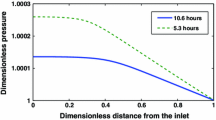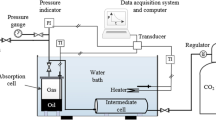Abstract
Volatile oil recovery by means of air injection is studied as a method to improve recovery from low permeable reservoirs. We consider the case in which the oil is directly combusted into small products, for which we use the term medium temperature oil combustion. The two-phase model considers evaporation, condensation and reaction with oxygen. In the absence of thermal, molecular and capillary diffusion, the relevant transport equations can be solved analytically. The solution consists of three waves, i.e., a thermal wave, a medium temperature oxidation (MTO) wave and a saturation wave separated by constant state regions. A striking feature is that evaporation occurs upstream of the combustion reaction in the MTO wave. The purpose of this paper is to show the effect of diffusion mechanisms on the MTO process. We used a finite element package (COMSOL) to obtain a numerical solution; the package uses fifth-order Lagrangian base functions, combined with a central difference scheme. This makes it possible to model situations at realistic diffusion coefficients. The qualitative behavior of the numerical solution is similar to the analytical solution. Molecular diffusion lowers the temperature of the MTO wave, but creates a small peak near the vaporization region. The effect of thermal diffusion smoothes the thermal wave and widens the MTO region. Capillary diffusion increases the temperature in the upstream part of the MTO region and decreases the efficiency of oil recovery. At increasing capillary diffusion the recovery by gas displacement gradually becomes higher, leaving less oil to be recovered by combustion. Consequently, the analytical solution with no diffusion and numerical solutions at a high capillary diffusion coefficient become different. Therefore high numerical diffusion, significant in numerical simulations especially in coarse gridded simulations, may conceal the importance of combustion in recovering oil.











Similar content being viewed by others
Abbreviations
- \(A_\mathrm{r}\) :
-
MTO reaction pre-exponential factor (1/s)
- \(c_\mathrm{l}, c_\mathrm{g}\) :
-
Heat capacity of liquid and gas (J/mol K)
- \(C_\mathrm{m}\) :
-
Heat capacity of porous matrix (J/\(\hbox {m}^{3}\) K)
- \(D_\mathrm{g}\) :
-
Gas-diffusion coefficient (\(\hbox {m}^2\)/s)
- \(f_\mathrm{l}\) :
-
Fractional flow function for liquid phase
- \(J\) :
-
Leverett \(J\)-function
- \(k\) :
-
Rock permeability (\(\hbox {m}^2\))
- \(k_\mathrm{l}, k_\mathrm{g}\) :
-
Liquid and gas phase permeabilities (\(\hbox {m}^2\))
- \(n\) :
-
MTO Reaction order with respect to oxygen
- \(P_\mathrm{g}\) :
-
Gas pressure (Pa)
- \(P_\mathrm{l}\) :
-
Liquid pressure (Pa)
- \(Q_\mathrm{r}\) :
-
MTO reaction enthalpy per mole of oxygen at reservoir temperature (J/mol)
- \(Q_\mathrm{v}\) :
-
Liquid fuel vaporization heat at reservoir temperature (J/mol)
- \(R\) :
-
Ideal gas constant (J/(mol K)
- \(s_\mathrm{l}, s_\mathrm{g}\) :
-
Saturations of liquid and gas phases
- \(t\) :
-
Time (s)
- \(T\) :
-
Temperature (K)
- \(T^{b}\) :
-
Boiling temperature of liquid at elevated pressure (K)
- \(T^\mathrm{ini}\) :
-
Reservoir temperature (K)
- \(T^\mathrm{ac}\) :
-
MTO activation temperature (K)
- \(u_\mathrm{l}, u_\mathrm{g}, u\) :
-
Liquid, gas and total Darcy velocities (m/s)
- \(u_\mathrm{gj}\) :
-
Darcy velocity of component \(j = h,o,r\) in gas phase (m/s)
- \(u_\mathrm{g}^\mathrm{inj}\) :
-
Injection Darcy velocity of gas (m/s)
- \(W_\mathrm{v}, W_\mathrm{r}\) :
-
Vaporization rate, and MTO reaction rate (mol/\(\hbox {m}^{3}\) s)
- \(x\) :
-
Spatial coordinate (m)
- \(Y_\mathrm{h}, Y_\mathrm{o}, Y_\mathrm{r}\) :
-
Gas molar fractions: hydrocarbons, oxygen, remaining components (mol/mol)
- \(Y_\mathrm{o}^\mathrm{inj}\) :
-
Oxygen fraction in injected gas
- \(\varphi \) :
-
porosity
- \(\kappa _\mathrm{l}\) :
-
Phase transfer parameter
- \(\lambda \) :
-
Thermal conductivity of porous medium (W/m K)
- \(\mu _\mathrm{l}, \mu _\mathrm{g}\) :
-
Viscosity of liquid and gas (Pa s)
- \(\nu _\mathrm{l}, \nu _\mathrm{g}\) :
-
Stoichiometric coefficients in the MTO reaction
- \(\rho _\mathrm{l}, \rho _\mathrm{g}\) :
-
Molar densities of liquid and gas (\(\hbox {mol/m}^{3}\))
- \(\sigma \) :
-
Liquid oil surface tension (N/m)
- \(\theta \) :
-
Liquid oil/rock contact angle
References
Abou-Kassem, J.H., Farouq, A., Ferrer, S.M.: Appraisal of steamflood models. J. Rev. Tec. Ing. 9, 45–58 (1986)
Adagülü, G., Akkutlu, I.: Influence of in-situ fuel deposition on air injection and combustion. J. Can. Pet. Technol. 46(4), 54–61 (2007)
Akin, S., Kok, M.V., Bagci, S., Karacan, O.: Oxidation of heavy oil and their SARA fractions: its role in modeling in-situ combustion. SPE 63230 (2000).
Bakry, A., Al-Salaymeh, A., Al-Muhtaseb, A.H., Abu-Jrai, A., Trimis, D.: Adiabatic premixed combustion in a gaseous fuel porous inert media under high pressure and temperature: Novel flame stabilization technique. Fuel 90(2), 647–658 (2011)
Bamford, C.H., Tipper, C.E.H.: Comprehensive Chemical Kinetics. Gas-phase Combustion. Elsevier, New York (1977)
Barzin, Y., Moore, R., Mehta, S., Mallory, D., Ursenbach, M., Tabasinejad, F.: Role of vapor phase in oxidation/combustion kinetics of high-pressure air injection (HPAI). In: SPE 135641 (2010).
Barzin, Y., Moore, R., Mehta, S., Ursenbach, M., Tabasinejad, F.: Impact of distillation on the combustion kinetics of high pressure air injection (HPAI). In: SPE 129691-Improved Oil Recovery Symposium (2010).
Bayliss, A., Matkowsky, B.J.: From traveling waves to chaos in combustion. SIAM J. Appl. Math. 54, 147–174 (1994)
Bear, J.: Dynamics of Fluids in Porous Media. Dover Publications Inc, Dover (1972)
Belgrave, J.D.M., Moore, R.G.: A model for improved analysis of in-situ combustion tube tests. J. Pet. Sci. Eng. 8(2), 75–88 (1992)
Bird, R.B., Stewart, W.E., Lightfoot, E.N.: Transport Phenomena. Wiley, New York (2002)
Bruining, J., van Duijn, C.J.: Traveling waves in a finite condensation rate model for steam injection. Comput. Geosci. 10(4), 373–387 (2006)
Bruining, J., Mailybaev, A.A., Marchesin, D.: Filtration combustion in wet porous medium. SIAM J. Appl. Math. 70, 1157–1177 (2009)
Castanier, L.M., Brigham, W.E.: Modifying in-situ combustion with metallic additives. Situ 21(1), 27–45 (1997)
Castanier, L.M., Brigham, W.E.: Upgrading of crude oil via in situ combustion. J. Pet. Sci. Eng. 39, 125–136 (2003)
Dietz, D.N., Weijdema, J.: Wet and partially quenched combustion. J. Pet. Technol. 20, 411–415 (1968)
Eftekhari, A.A., Van Der Kooi, H., Bruining, J.: Exergy analysis of underground coal gasification with simultaneous storage of carbon dioxide. Energy 45(1), 729–745 (2012)
Fassihi, M., Brigham, W., Ramey Jr, H.: Reaction kinetics of in-situ combustion: Part 1-observations. Old SPE J. 24(4), 399–407 (1984)
Fickett, W., Davis, W.C.: Detonation: Theory and Experiment. Dover, Mineola (2011)
Fisher, E.M., Pitz, W.J., Curran, H.J., Westbrook, C.K.: Detailed chemical kinetic mechanisms for combustion of oxygenated fuels. Proc. Combust. Inst. 28(2), 1579–1586 (2000)
Freitag, N.P., Verkoczy, B.: Low-temperature oxidation of oils in terms of SARA fractions: why simple reaction models don’t work. J. Can. Pet. Technol. 44(3), 54–61 (2005)
Germain, P., Geyelin, J.L.: Air injection into a light oil reservoir: the Horse Creek project. In: Middle East Oil Show and Conference, SPE-37782-MS (1997).
Gerritsen, M., Kovscek, A., Castanier, L., Nilsson, J., Younis, R., He, B.: Experimental investigation and high resolution simulator of in-situ combustion processes; 1. Simulator design and improved combustion with metallic additives. In: SPE International Thermal Operations and Heavy Oil Symposium and Western Regional Meeting, SPE-86962-MS (2004).
Greaves, M., Ren, S., Rathbone, R., Fishlock, T., Ireland, R.: Improved residual light oil recovery by air injection (LTO process). J. Can. Pet. Technol. 39(1) ISSN0021-948 (2000).
Greaves, M., Young, T.J., El-Usta, S., Rathbone, R.R., Ren, S.R., Xia, T.X.: Air injection into light and medium heavy oil reservoirs: combustion tube studies on west of shetlands clair oil and light australian oil. Chem. Eng. Res. Des. 78(5), 721–730 (2000)
Gutierrez, D., Skoreyko, F., Moore, R., Mehta, S., Ursenbach, M.: The challenge of predicting field performance of air injection projects based on laboratory and numerical modelling. J. Can. Pet. Technol. 48(4), 23–33 (2009)
Hardy, W.C., Fletcher, P.B., Shepard, J.C., Dittman, E.W., Zadow, D.W.: In-situ combustion in a thin reservoir containing high-gravity oil. J. Pet. Technol., SPE-3053-PA, 24(2), 199–208 (1972).
Helfferich, F.G.: Kinetics of Multistep Reactions, vol. 40. Elsevier Science Limited, Amsterdam (2004)
Khoshnevis Gargar, N., Achterbergh, N., Rudolph-Flöter, S., Bruining, H.: In-Situ oil combustion: processes perpendicular to the main gas flow direction. In: SPE Annual Technical Conference and Exhibition, volume SPE 134655-MS (2010).
Kok, M.V., Karacan, C.O.: Behavior and effect of SARA fractions of oil during combustion. SPE Reserv. Eval. Eng. 3, 380–385 (2000)
Kulikovskii, A.G., Pashchenko, N.T.: Propagation regimes of self-supported light-detonation waves. Fluid Dyn. 40(5), 818–828 (2005)
Levenspiel, O.: Chemical Reaction Engineering. Wiley, New York (1999)
Lin, C.Y., Chen, W.H., Lee, S.T., Culham, W.E.: Numerical simulation of combustion tube experiments and the associated kinetics of in-situ combustion processes. SPE J. 24, 657–666 (1984)
Lin, C.Y., Chen, W.H., Culham, W.E.: New kinetic models for thermal cracking of crude oils in in-situ combustion processes. SPE Reserv. Eng. 2, 54–66 (1987)
Mailybaev, A.A., Bruining, J., Marchesin, D.: Analysis of in situ combustion of oil with pyrolysis and vaporization. Combust. Flame 158(6), 1097–1108 (2011)
Mailybaev, A.A., Marchesin, D., Bruining, J.: Resonance in low-temperature oxidation waves for porous media. SIAM J. Math. Anal. 43, 2230 (2011)
Mailybaev, A.A., Marchesin, D., Bruining, J.: Recovery of light oil by medium temperature oxidation. Transp. Porous Media 97(3), 317–343 (2013)
Matkowsky, B.J., Sivashinsky, G.: Propagation of a pulsating reaction front in solid fuel combustion. SIAM J. Appl. Math. 35, 465–478 (1978)
Oleinik, O.A.: Construction of a generalized solution of the cauchy problem for a quasi-linear equation of first order by the introduction of vanishing viscosity. Uspekhi Matematicheskikh Nauk 14(2), 159–164 (1959)
Peaceman, D.W.: Fundamentals of Numerical Reservoir Simulation, vol. 6. Elsevier, New York (1977)
Pereira, F.M., Oliveira, A.A.M., Fachini, F.F.: Asymptotic analysis of stationary adiabatic premixed flames in porous inert media. Combust. Flame 156(1), 152–165 (2009)
Poling, B.E., Prausnitz, J.M., John Paul, O.C., Reid, R.C.: The Properties of Gases and Liquids. McGraw-Hill, New York (2001).
Prigogine, I.: Introduction to Non-equilibrium Thermodynamics. Wiley, New York (1962)
Sanmiguel, J., Mallory, D., Mehta, S., Moore, R.: Formation heat treatment process by combustion of gases around the wellbore. J. Can. Pet. Technol. 41(8) ISSN0021-9487 (2002).
Schott, G.L.: Kinetic studies of hydroxyl radicals in shock waves. III. The OH concentration maximum in the hydrogen-oxygen reaction. J. Chem. Phys. 32, 710 (1960)
Schult, D.A., Matkowsky, B.J., Volpert, V.A., Fernandez-Pello, A.C.: Forced forward smolder combustion. Combust. Flame 104, 1–26 (1996)
Schulte, W.: Challenges and strategy for increased oil recovery. In: International Petroleum Technology Conference, Doha, Qatar (2005).
Sharpe, G.J., Falle, S.: One-dimensional nonlinear stability of pathological detonations. J. Fluid Mech. 414(1), 339–366 (2000)
von Rosenberg, D.U.: Methods for the Numerical Solution of Partial Differential Equations, vol. 16. American Elsevier, New York (1969)
Wahle, C.W., Matkowsky, B.J., Aldushin, A.P.: Effects of gas-solid nonequilibrium in filtration combustion. Combust. Sci. Tech. 175, 1389–1499 (2003)
Welge, H.J.: A simplified method for computing oil recovery by gas or water drive. Trans. AIME 195, 91–98 (1952)
Whitham, G.B.: Non-linear dispersion of water waves. J. Fluid Mech. 27(02), 399–412 (1967)
Whitham, G.B.: Linear and Nonlinear Waves, vol. 42. Wiley-Interscience, New York (2011)
Wood, W.W., Salsburg, Z.W.: Analysis of steady-state supported one-dimensional detonations and shocks. Phys. Fluids 3, 549–566 (1960)
Xu, Z., Jianyi, L., Liangtian, S., Shilun, L., Weihua, L.: Research on the mechanisms of enhancing recovery of light-oil reservoir by air-injected low-temperature oxidation technique. Nat. Gas Ind. 24, 78–80 (2004)
Zheng, C.H., Cheng, L.M., Li, T., Luo, Z.Y., Cen, K.F.: Filtration combustion characteristics of low calorific gas in sic foams. Fuel 89(9), 2331–2337 (2010)
Acknowledgments
This research was carried out within the context of the ISAPP Knowledge Centre. ISAPP (Integrated Systems Approach to Petroleum Production) is a joint project of the Netherlands Organization of Applied Scientific Research TNO, Shell International Exploration and Production, and Delft University of Technology. The paper was also supported by Grants of PRH32(ANP 731948/2010, PETROBRAS 6000.0061847.10.4), FAPERJ(E-26/102.965/2011, E-26/111.416/2010, E-26/110.658/ 2012, E-26/110.237/2012, E-26/111.369/2012) and CNPq (301564/2009-4,472923/2010-2, 477907/2011-3, 305519/2012-3, 402299/2012-4, 470635/2012-6) and Capes/Nuffic 024/2011. The authors thank TU Delft and IMPA for providing the opportunity for this work.
Author information
Authors and Affiliations
Corresponding author
Rights and permissions
About this article
Cite this article
Khoshnevis Gargar, N., Mailybaev, A.A., Marchesin, D. et al. Diffusive Effects on Recovery of Light Oil by Medium Temperature Oxidation. Transp Porous Med 105, 191–209 (2014). https://doi.org/10.1007/s11242-014-0366-8
Received:
Accepted:
Published:
Issue Date:
DOI: https://doi.org/10.1007/s11242-014-0366-8




